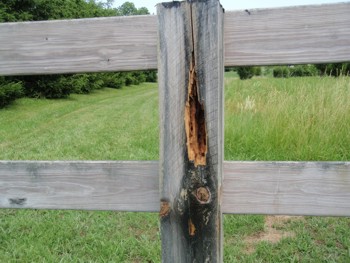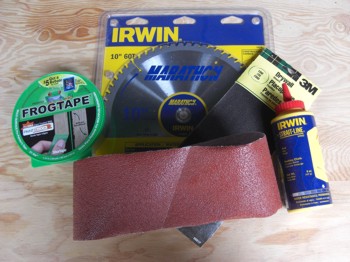Here is a link to the Bosch 3727DEVS 3.3 Amp 6-Inch Hook and Loop Random Orbit Variable Speed Sander/Polisher with Dust CanisterDisc Sanders)
on Amazon.com. This is an affiliate link. I get a tiny commission if you purchase this item from Amazon.
Bosch Hammer Drill Driver Video
Here is a link for the Bosch HDH181-01 18V Brute Tough Hammer Drill Driver with (2) 3.0ah Batteries on Amazon.com. This is an affiliate link. I get a tiny commission if you purchase this item from Amazon.
Bosch Multi Tool Video
Here is a link to the Bosch MX25EC-21 2.5-Amp Multi-X Oscillating Tool Kit on Amazon.com. This is an affiliate link. I get a tiny commission if you purchase this item from Amazon.
Bosch Daredevil Spade Bit Video
Here is a link to the Bosch DSB5013P DareDevil 13-Piece Spade Bit SetSpade Drill Bits)
on Amazon.com where you can purchase this drill driver. This is an affiliate link. I get a tiny commission if you buy the tool.
DeWALT Compact Drill Driver Video
Hi, I'm Tim Carter. I've got the new DeWALT 20V Max Cordless Drill. Watch how fast this drills. It's pretty amazing. I'm telling you, it's just like I have a corded drill.
It's really cool. You're going to love it.
Here is a link to the DeWALT DCD780C2 20-Volt MAX Li-Ion Compact Drill/Driver Kit, 1.5 Ah on Amazon.com where you can purchase this drill driver. This is an affiliate link. I get a tiny commission if you buy the tool.
DeWALT Compact Hammer Drill Video
Here's a link to the DeWALT DCD785C2 20-Volt MAX Li-Ion Compact Hammerdrill/Driver Kit, 1.5 Ah on Amazon.com where you can purchase this item. It's an affiliate link. I get a tiny commission if you buy the tool.
Preventing Woodpecker Holes
DEAR TIM: Woodpeckers are systematically destroying some fence posts in my yard. I’m at my wits end trying to figure out how to stop them. Are there chemical sprays I can put on the wood that will repel them? What about decoys or something like a scarecrow? Do you know of anything that will work to stop them from making my fence look like a piece of Swiss cheese? Shirley S., Hamilton, OH
DEAR SHIRLEY: Oh I can absolutely feel your frustration. Woodpeckers used my past house to find their mates by pecking on my aluminum gutters at dawn. Who needs an alarm clock or rooster when you have these hard-headed birds heralding the start of another day?

It's almost impossible to stop woodpeckers from creating holes like this. But there is a way to fool them. PHOTO CREDIT: Shirley Sendelbach
Add to that the fact they used to peck holes in several of the fascia boards around my house just as they’re doing to your fence posts. No matter how hard I tried, I couldn’t get them to stop.
They only stopped when they exhausted the food supply. You see, woodpeckers hammer at trees and other wood primarily for one reason: Food. Hidden just under the surface, woodpeckers can find all sorts of tasty insects including, but not limited to, carpenter ants, carpenter bee larvae, termites, bugs in general, etc.
I’m convinced that woodpeckers can hear or smell the insects. You don’t see woodpeckers in the wild randomly peck at wood that’s not infested with insects. I know as I live near the woods and I see woodpeckers all the time. They don’t bother wood that’s free of insects.
If this assumption is correct, then it becomes somewhat easy to prevent woodpecker holes. You keep the wood you have free from insects by preventing rot and decay. In the case of your fence posts, this means they need to be sealed regularly so that water can’t saturate the wood. Wet wood is very inviting to insects.

PHOTO CREDIT: Shirley Sendelbach
If I were you, I’d remove the damaged fence posts and replace them with wood that you’ve sealed with a semi-transparent water repellant. Be sure you allow the bottom and the top of the post to soak in liquid for an hour or so. This allows the end grain of the wood to soak up as much of the chemical as possible.
Don’t get rid of the damaged fence post. Move it away from the fence to some other part of your yard. Reinstall it in the ground and let the woodpeckers have at it. Make a humorous sign that says: "Woodpeckers and Insects Welcome" and hang this on the post.
The old post will satisfy the hard-coded survival DNA in the woodpeckers as they constantly forage for food. If woodpeckers are attacking your house, then you can try this same strategy using some old log you can find. Bring it home and put it up as a totem pole offering in your backyard. Hopefully the woodpeckers will be attracted to it assuming it’s full of tasty treats.
You may be groaning at the task of replacing your perforated fence post with a new one, especially if the old one is set in concrete. If that’s the case, this will be the last time you’ll struggle with this fence post location.
The trick is to set the new post with just soil or crushed gravel if you feel you need a masonry support collar. Crushed gravel will perform just as good as concrete. The advantage is that it’s so much easier to remove the gravel if you should ever have to replace the fence post in the future.
 If you decide to apply the water repellant to the entire wood fence, you should clean it first. Use oxygen bleach mixed with water for this task. The oxygen bleach will not harm any surrounding vegetation. It will return the wood to it’s original color so the new fence post matches all the other fencing.
If you decide to apply the water repellant to the entire wood fence, you should clean it first. Use oxygen bleach mixed with water for this task. The oxygen bleach will not harm any surrounding vegetation. It will return the wood to it’s original color so the new fence post matches all the other fencing.
The oxygen bleach will remove dirt, mold, algae and sun-damaged wood fibers that are now gray in color. Rinse the clean wood with fresh water and allow it to dry a day before applying the water repellant.
Search online and you’ll discover other ideas to repel woodpeckers. Some are unreasonable and may get you in trouble with your neighbors. Who want’s a neighbor banging pots and pans or letting off fireworks in an attempt to get rid of the birds?
You can try to create large silhouettes of birds of prey that eat woodpeckers. These may work for a while, but don’t underestimate the intelligence of the little devils. When they’re hungry, they’ll soon probably test to see if you handiwork is a real bird.
If you want to attempt to use insecticides to kill the food source, be sure the chemicals are approved and will not hurt the water supply in your area. The last thing you want is to pollute the water and start to grow a tail or a third eyeball.
Column 887
June 7, 2011 AsktheBuilder Tips And Newsletter
What's in This Newsletter?
Latest News
Wall-Mount Pocket Doors
DeWALT Editors Conference
ExpertToolTips.com
DIY Solar System and Magic Crystals
Replacement Parts
AsktheBuilder Facebook Fan Highlights
Summer's here in all it's glory. We're having some glorious weather here in New Hampshire. I hope the weather is superb where you are.A few days ago I had a very positive encounter with Officer Kimberly Shelley of the Burlington, VT police department. It's a very long story, but suffice it to say she made a phone call on my behalf to shake loose a security deposit that was not being returned to me by an unprofessional property manager.
I was told to call the police department after talking with another police officer, Lt. Rob Robillard. I've recently come to know Rob, and after hearing my story he was convinced the property manager was very likely committing fraud.
I bring all this up to simply point out that on many occasions great police work goes unnoticed. The moment that I get my hands on the deposit money, I'll be writing a letter to the police chief in Burlington, VT telling him about Officer Kimberly and how she worked with me on the phone to resolve the matter. The letter will include a scanned copy of the returned check. If you're the recipient of excellent police work, be sure to take the time to contact her/his chief so the officer gets the professional recognition she/he deserves.
Wall-Mount Pocket Doors
 Many people want to get rid of a traditional hinged door and replace it with a sleek pocket door.
Many people want to get rid of a traditional hinged door and replace it with a sleek pocket door.
But they are terrified of what's behind the wall. Or they don't have the skills to do the demolition, framing and redrywalling you typically have to do.
What if I told you that you could have a pocket door in place of a hinged door start to finish in several hours instead of days with NO DEMOLITION?
Yes, I knew you'd be interested. If you can operate a simple impact driver or a drill and a socket wrench, then you can have a sweet pocket door installed in hours at your home.
This product works GREAT on regular open archways where you now want privacy between two rooms that used to be open to one another. You can use this solution to add a door in hours where just an opening was before. It's easy to do.
Go to the link below to discover all sorts of color photos and ideas for your new wall-mounted pocket door:
DeWALT Editors Conference
Last week I attended the Stanley Black and Decker University.
It was a fantastic experience where I was immersed in the new 20-volt cordless tool line that's now here. The other editors and I also got to see many new hand tools that will now sport the DeWALT name.
DeWALT primarily targets the professional market, but their tools are perfectly suited for you if you're either a serious DIY'er or you desire to have a tool that will last for decades.
Understand that when you purchase a high-quality tool you get durability, precision, and ease of use. These all contribute to a job well done.
Soon I'll begin my own field testing of the tools I saw at the event. You'll be the first to know about each review as it get's posted to my websites. Websites you say? Read the next item.
ExpertToolTips.com
About six years ago, I created ExpertToolTips.com, but then got distracted. The intention was to create a website where I could share my 35 years worth of hands-on experience with tools.
The good news is that I've started to add more content to that website and intend to load more and more content to it as well as helpful eguides that show you secrets of using tools. I believe you're going to really like this tools website once it starts to get populated with content.
DIY Solar System and Magic Crystals
Over the weekend, I got an email from David Gates who lives in Duncannon, PA. He wrote:
The instant after reading it, I had a flashback to the Napoleon Dynamite movie from six years ago. If you saw it, do you remember the crude time machine that Napoleon and Kip tried? It was made from parts one could get at a hardware store and of course all it did was shock Napoleon and endanger his ability to procreate. The magic crystals he inserted in the romex connector did nothing to transport Napoleon back in time.
As the economy continues to crater and people become desperate for money, you're going to see many more scams like this. There are always going to be scams, and the worst ones happen when people are desperate.
The bottom line is that you can't build a solar electricity generation system, including the all-important PV panels and the inverter, by visiting your local hardware store. Don't fall for scams like this. Always check with me first.
Replacement Parts
Greg, from Las Vegas, also emailed me over the weekend trying to locate a replacement circuit board for a sauna. He did an exhaustive Google search and it shows the manufacturer is out of business. He's tried everything to get a part, but is having no luck.
The message here is that in this day and age, it's very possible that hi-tech replacement parts can be tough to find. Margins are thin, and companies that make products can disappear overnight.
You have to really think ahead when you buy things now. Make sure you think about parts and consider going with companies that have a great track record. You want them to be around when you need them.
AsktheBuilder Facebook Fan Highlights
Last week on the AsktheBuilder Facebook Fan Page, I shared my thoughts about how to protect yourself from tornadoes while in your home.
Peggy asked how to install return air ducting and I gave her some advice.
I also suggested a great past column to read if you want to try to reduce the heat in a garage or an attic.
There's lots going on at Facebook. You should really be a fan. Facebook is free and you get automatic updates of everything I do there once you LIKE me. It's easy.
Window Box Installation Tips
DEAR TIM: My wife wants me to install a window box or flower box, depending on what you call them. I’m pretty sure that if I’m successful, I’ll be installing a few more.
The boxes, when full of potting soil, plants and watered are pretty heavy. I’m very concerned that the box is going to fall and crash to the ground.
What have you found to work best when installing these decorative items. I sure need your help, as I don’t want to upset my bride. - Don B., Staten Island, NY
DEAR DON: Oh I’m quite aware of the wrath you might feel if your window box plummets to the earth scattering the plants and flowers.
Plants are Children - Beware!
My wife treats her plants like they are her children, and if I ever step on one or otherwise mistakenly cut one off with the weed trimmer, I’m in the dog house for quite some time.

Window boxes full of flowers can be used under windows or to add color to deck railings. They are sure to please. PHOTO CREDIT: Tim Carter
You do want to succeed at this task for any number of reasons. First and foremost is the safety of anyone who might walk under the window.
You sure don’t want a window flower box to detach from a wall and fall on someone’s head. It’s happened before and surely will happen again.
Free & Fast Bids
CLICK HERE to get FREE & FAST BIDS from local handymen that can install your flower boxes FAST!
There are several ways to support a flower box, the most common being metal brackets that are screwed to the wall. The challenge when using a bracket is to make sure the screws go into solid lumber. The only problem with this approach is that the placement of the brackets might not be centered under the flower box. Centering brackets on a masonry wall is easy, and it’s easy to anchor them for solid support. However, many houses have wood or vinyl siding with the wall studs undoubtedly off center.
This is why I usually don’t use brackets choosing to use hidden french cleats instead. A french cleat is a time-tested method to secure pictures, mirrors, mantles, and even a window box to a wall surface.
The french cleat is a two-piece connection system where the piece of wood or metal that’s attached to the window box interlocks with the mating piece that’s attached to the wall. The best part is that once installed the window box appears to be floating in mid-air with no visible means of support.

It’s easiest to use lumber to create a french cleat. I highly recommend using treated lumber in your case since the wood will be subjected to water. You don’t want the french cleat to rot over time and fail causing the window box to crash to the ground.
The french cleat can be made from 3/4-inch-thick material. You need a piece of lumber that’s about 3-inches wide and as long as the window box.
The magic happens when you cut the single piece of lumber into two pieces along its length. You need either a circular hand saw, or better yet, a table saw with the blade set at a 45 degree angle.
By splitting the piece of wood down the middle with the saw set at the angle, you create two pieces of lumber that look identical, but one actually interlocks with the other when mated together. This is what’s going to hold the window box to the wall.
CLICK HERE to get FREE & FAST BIDS from local handymen that can install your flower boxes FAST!
The piece of lumber that attaches to the window box is screwed to the window box so that the angled cut points to the ground and the long tip of the cut is not touching the back of the window box. The flat or square edge of this piece is usually flush with the top of the rear of the window box.
The other piece of lumber gets screwed to the wall of the house with the angled cut pointing up to the sky and the long point not touching the wall.
I’m sure you can see how when you bring the window box over to the wall and allow the two pieces of lumber to interlock that the box will be securely attached to the wall. The only tricky measuring you have to do is to calculate how far below the bottom of the window sill or window frame to attach the piece to the house.
Typically the top of the window box, once installed, is a inch or so below the window sill or the outer frame of the window. It’s easy to do the math to see where the bottom of the house piece needs to be in order for the box to be at the right height. If you started with a piece of lumber 3-inches wide, the square bottom of the house piece needs to be 4 inches below the bottom of the window sill or window frame.
The pieces of treated lumber that are screwed to the house as well as the window box need to be attached using galvanized or stainless-steel fasteners. These will not rust.
When you attach the one half of the cleat to the house wall, be sure it’s parallel with the bottom of the window sill or the window frame. You’ll be tempted to use a level for this task, but that could be a mistake. You don’t want the window box level if the bottom of the window itself is not level. It will look like you made a mistake after you’re done.
You may have to install one or two 3/4-inch blocks of wood on the lower rear corners of the window box to ensure the box doesn’t tip. The french cleat will hold the back of the window box away from the wall, so the blocks ensure that the top of the box is level front to back. These blocks will not be seen when you look straight on the box.
CLICK HERE to get FREE & FAST BIDS from local handymen that can install your flower boxes FAST!
Column 886
Paying for Construction Tools
DEAR TIM: My contractor submits bills for labor and materials and I reimburse him. However, I'm noticing items such as $50 "Diamond Blade" and other tools on the bills. Is it normal for the contractor or the homeowner to pay for a special tool or blade that he chooses to purchase to use for the project? What about replacement parts? I want to be fair, but I don’t wish to be cheated. How would you handle this situation? Kimberly McL., Calgary, Alberta, Canada
DEAR KIMBERLY: Let me start by saying that you, as a homeowner, should pay for construction tools and equipment that are completely consumed on your job. Some examples of that are pretty easy to identify. Labor, materials, and other supplies like fuel for machines, sandpaper, certain blades, etc. These things become part of your home and/or can’t be used at another location after the job is done because there is nothing left or they are unusable.

Blades, sandpaper, chalk, masking tape, etc. are tools that can get totally consumed on a job and should be paid for by the homeowner. PHOTO CREDIT: Tim Carter
However there is a massive gray area and I hope that the written contract you have with your contractor spells out what’s to happen in certain situations. Believe me, it’s easy for you to get taken advantage of in a labor and material or cost-plus deal like you describe.
If I was working for you, this is how I would have negotiated the contract. First, I would have a small multiplier, similar to a sales tax, that gets added to every bill I submit to you. This small percentage, say one percent, covers wear and tear on the tools I already own and will be using on your job. This would even include wear and tear on my truck that I drive to your job each day. All of these things eventually wear out and the cost needs to be spread out proportionately over all the jobs where they are used.
This financial arrangement takes care of preowned tools pretty nicely. The multiplier that’s used can seem like fuzzy math, because some tools have a much longer lifespan than others. A truck may last ten years or more where a circular saw that’s used each day for hours may give up the ghost after three years. You’ll have to trust the contractor is not charging you an excessive amount for the use of his tools.
When it comes to new construction tools that have to be purchased for your job, I would have said in my contract with you that either you get the tool at the end of the job, after all - you paid for it, or I can buy it from you at a slightly discounted price deducting the wear and tear that was placed on it during your job. If neither party wants the tool, it can be donated to a local charity that uses tools or it can be sold in the open marketplace. It’s easy to sell tools using free online classified ad websites.
You can sometimes skirt this issue entirely and rent the needed tool. Why buy a tool if it’s only needed one day? The problem is that tool rental costs can soar if a tool is needed for a long time. Then it makes sense to buy the tool, but the ownership of the tool needs to be spelled out before it’s purchased.
In your case, the $50 diamond blade gets a little tricky. The contractor may not have owned one, and indeed needed it for your job. However, the entire blade may not be used up after he’s finished with it. It could have lots of cutting time left on it. In this case, I would have offered to buy it from you at a discounted price. If not, I’d leave the blade at your home for you to decide what to do with it.
Replacement parts for construction tools are another fuzzy area. Let’s say that while the contractor is at your house, the motor on his electric concrete mixer gives up the ghost. The part may cost hundreds of dollars.
There is no way you should have to pay for the cost of the new motor as it was wearing out for years when it was used on other jobs. It’s reasonable for you to pay a small part of the part cost as the mixer, once up and running again, will be used for your benefit. I say this assuming the motor will last for several years after it leaves your job site.
I’ve got some advice for you in the future. Try to minimize the number of situations where you use a cost-plus system of paying for a job. They are fraught with uncertainty and can cause all sorts of anxiety about what the final bill will be. Whenever possible always work with a fixed-sum contract where the contractor agrees to one price no matter what happens.
There are times in certain jobs, where there are unknowns. For example, a contractor digging a basement may have a rock clause in case he hits bedrock and has to blast or use special equipment that digs slower. In roofing work, there may be a clause to pay for rotted wood under shingles that can’t be seen until the roof is stripped off.
The trick is to identify just those parts of the job where the uncertainty lies and work those on a cost-plus basis. Once that part of the job is complete, then the contractor is back on his fixed-sum contract.
This arrangement gives you much tighter control of the finances of a job. You should be able to sleep better and you’ll not care how many diamond blades or sheets of sandpaper a contractor buys. It’s up to him to be frugal with the amount of money that you agreed to in the contract.
Column 885